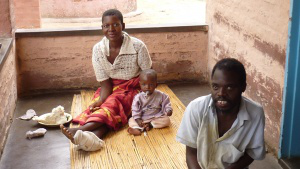Holy Week appeal from Zimbabwe Leprosy settlement

Family in Mutemwa - image ICN
We have received a Holy Week appeal from the John Bradburne Memorial Society, on behalf of the Mutemwa Leprosy Settlement in north eastern Zimbabwe.
Although leprosy is curable now, the disease carries such a stigma, former patients are not accepted back in their communities. At present there are 40 leprosy patients here - all burnt-out due to the new drugs - but many suffer deformities. Mutemwa cares for about twenty destitute disabled people as well. The Zimbabwean government pays a basic grant for medicines and food but the project relies on donations for clothing, supplementary rations and everything else.
Within living memory, the disease was incurable and leprosy patients were left out in the bush to die. Mutemwa started as a kind of hospice for them in about 1937. By the 1950s there were up to 1,000 patients there, from several African countries.
By the 1950s, new drugs had become very effective. It was decided to close down the centre. The clinic moved out in 1962, leaving patients, who still suffered from leprosy-related conditions and great disfigurements, to fend for themselves. The wife of a local magistrate noticed their plight and in 1968 formed a small group called 'The Friends of Mutemwa'.
Around this time John Bradborne arrive from England as a missionary helper. A charismatic figure, he belonged to the Third Order of St Francis, was an accomplished poet and had walked to Rome in his younger days.
In 1969 he became warden of the Mutemwa leprosy settlement and worked tirelessly to improve conditions of the people there. Friends urged him to quit Zimbabwe when the 'bush war' against white rule escalated in the late 70s, but he refused. The single-minded loving care he gave the residents eventually brought him into conflict with the management committee. Because he refused to put number tags around the patients' necks and reduce their already small diet, he was sacked. He then lived in a tin hut, lacking water and sanitation, just outside the leprosy compound. From there he prayed daily and continued to help the lepers as much as he could.
It seems that his efforts to prevent exploitation of the leprosy patients brought local hostility and suspicion. He was abducted by guerrillas and on 5 September 1979, he was shot. His body was found by the roadside near Mutemwa.
Other missionaries carried on his work, and conditions are much better. Mutemwa has become a place of pilgrimage these days. Many people come to visit the residents and Mass is celebrated in John Bradburne's hut. A memorial cross now stands on Chigona, the place where John prayed each day. An annual pilgrimage, which includes a long trek up the rock, attracts 35,000 people. There have been many claims of unusual cures and calls for John's beatification.
Donations can be sent to Celia Brigstocke, Secretary, The John Bradburne Memorial Society (JBMS), PO Box 32, Leominster, Herefordshire, HR6 0YB.
For more information see: www.johnbradburne.com
Additionally, an electronic copy of Fr John Dove's book on John Bradburne and Mtemwa is available on request from zvesvondo@aol.com


















